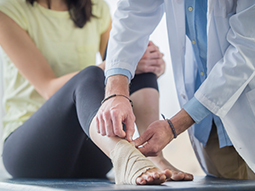Knee arthritis is an inflammation of the tissues that cushion the knee joint where your bones meet. This inflammation can cause pain, swelling, and joint damage. Other symptoms of arthritis in the knee may include:
-
A weak and painful feeling in the knee
-
Difficulty moving the knee
-
Difficulty walking
-
Instability in the knee
-
Stiffness and swelling in the knee area
There are more than 100 forms of arthritis, but the following types are most likely to cause knee pain:
Osteoarthritis
Osteoarthritis is the most common form of arthritis and affects millions of people worldwide. Osteoarthritis in the knee occurs when the protective cartilage between the knee joint bones wears down over time.
Rheumatoid arthritis
Rheumatoid arthritis is an inflammatory disease that leads to painful swelling in affected joints, including the knee. As a form of chronic knee pain, rheumatoid arthritis knee symptoms may come and go.
Gout
Gout occurs when uric acid crystals form in a joint, causing severe, burning pain and swelling. It's a form of arthritis that causes sudden and severe pain, swelling, redness, and tenderness in the joints, often at the base of the big toe. However, gout may also occur in the knee.
Arthritis gradually worsens over time but early treatment may lessen its impact on your life. Although there is no cure without surgery, we offer many nonsurgical treatment options to help you manage your knee pain and participate in the activities you enjoy.
Kneecap bursitis
A bursa is a small sac of fluid that cushions joints, muscles, and tendons. When the bursa located over the kneecap (prepatellar bursa), becomes inflamed or irritated, it is called kneecap bursitis. This is most commonly found in people who spend long periods kneeling, such as gardeners, carpet layers, and plumbers. Gout or rheumatoid arthritis may also cause kneecap bursitis.
In many cases, you may experience pain relief from nonsurgical treatments, including physical therapy, activity modification, or anti-inflammatory medication. If nonsurgical knee pain treatments don’t help, your doctor may recommend knee arthroscopy, a type of knee surgery, to remove the inflamed bursa.
Damage to an existing knee replacement
If you’ve had a total knee replacement, the artificial knee needs to remain firmly attached to the bone for your knee joint to move the way it’s supposed to. Occasionally, this implant may loosen from the underlying bone which causes pain in the knee. It’s not always clear what causes this to happen, but it can be a result of the following:
-
High-impact activities
-
Obesity
-
Wear and tear of the plastic spacer within the implant
-
Infection
If you undergo a total knee replacement when you’re young, you may be at a higher risk of a loosening knee prosthesis because you may outlive the life expectancy of your artificial knee. When that happens, you will need knee revision surgery to treat your knee.
Osgood-Schlatter disease
Osgood-Schlatter disease occurs in active children ages 9 to 14 when the growth plate at the front of the knee joint becomes irritated after a growth spurt. This results in swelling below the kneecap where a small lump may form. Rest, stretching, and anti-inflammatory medications may provide knee pain relief.
Our providers

Expert orthopedic care
Getting the care you need starts with seeing one of our orthopedic specialists









